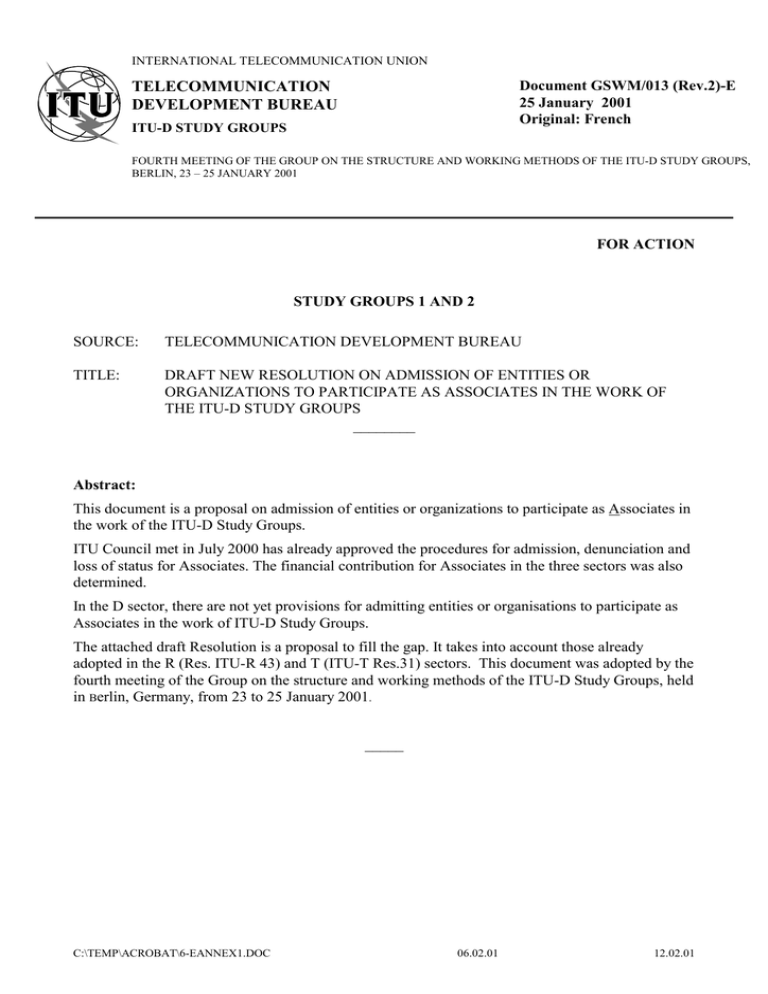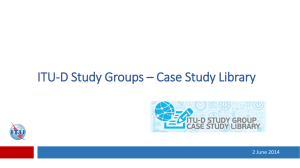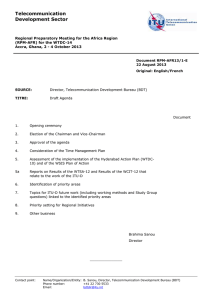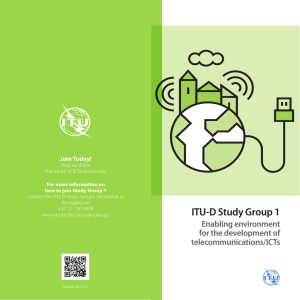TELECOMMUNICATION DEVELOPMENT BUREAU Document GSWM/013 (Rev.2)-E
advertisement

INTERNATIONAL TELECOMMUNICATION UNION Document GSWM/013 (Rev.2)-E 25 January 2001 Original: French TELECOMMUNICATION DEVELOPMENT BUREAU ITU-D STUDY GROUPS FOURTH MEETING OF THE GROUP ON THE STRUCTURE AND WORKING METHODS OF THE ITU-D STUDY GROUPS, BERLIN, 23 – 25 JANUARY 2001 FOR ACTION STUDY GROUPS 1 AND 2 SOURCE: TELECOMMUNICATION DEVELOPMENT BUREAU TITLE: DRAFT NEW RESOLUTION ON ADMISSION OF ENTITIES OR ORGANIZATIONS TO PARTICIPATE AS ASSOCIATES IN THE WORK OF THE ITU-D STUDY GROUPS ________ Abstract: This document is a proposal on admission of entities or organizations to participate as Associates in the work of the ITU-D Study Groups. ITU Council met in July 2000 has already approved the procedures for admission, denunciation and loss of status for Associates. The financial contribution for Associates in the three sectors was also determined. In the D sector, there are not yet provisions for admitting entities or organisations to participate as Associates in the work of ITU-D Study Groups. The attached draft Resolution is a proposal to fill the gap. It takes into account those already adopted in the R (Res. ITU-R 43) and T (ITU-T Res.31) sectors. This document was adopted by the fourth meeting of the Group on the structure and working methods of the ITU-D Study Groups, held in Berlin, Germany, from 23 to 25 January 2001. _____ C:\TEMP\ACROBAT\6-EANNEX1.DOC 06.02.01 12.02.01 -2– TDAG-5/6-E Annex 1 GSWM/013(Rev.1)-E DRAFT NEW ITU-D RESOLUTION XXX Admission of entities or organizations to participate as Associates in the work of ITU-D The World Telecommunication Development Conference (WTDC-2002), considering a) that the rapid pace of change in the telecommunication environment and in industry groups dealing with telecommunications demand the increased participation of interested entities and organizations in the development activities of ITU; b) that entities or organizations, in particular those with highly focused areas of activity, may be interested only in a small part of the development work of ITU-D and, therefore, do not intend to apply for membership in the Sector, but would be willing to join if simpler conditions existed; c) that Article 19 of the Convention (ADD 241A) enables the Sectors to admit entities or organizations to participate as Associate in the work of a given study group or sub-group thereof; d) that Articles 19, 20 and 33 of the Convention (ADD 241A, ADD 248B and ADD 483A, respectively) describe the principles for the participation of Associates, resolves 1 that an interested entity or organization may join ITU-D as an Associate and be entitled to take part in the work of a selected single study group and its subordinate groups; 2 that Associates are limited to the study group roles described below and excluded from all others: • Associates may take part in the process of preparing recommendations within a study group, including the following roles: meeting participant, contribution submitter and provider of comments in the process of approval of recommendations; • Associates may have access to documentation required for their work; • An Associate may serve as a co-rapporteur, responsible for directing the studies for the relevant study Question within the selected study group, except for liaison activities which are to be handled separately, 3 that the amount of the financial contribution for Associates be based upon the contributory unit for Sector Members as determined by Council for any particular biennial budgetary period, requests 1 the Secretary-General to admit entities or organizations to participate as Associates in the work of a given study group or subgroups thereof following the principles set in CV/Art.19, 241B, 241C, 241D, 241E, 2 TDAG to review on an ongoing basis the conditions governing the participation (including financial impact on the sector budget) of Associates based on the experience gained within ITU-D; instructs the Director of BDT to prepare the necessary logistics for the participation of Associates in the work of the ITU-D Study Groups, including possible impacts of study group reorganization. C:\TEMP\ACROBAT\6-EANNEX1.DOC



